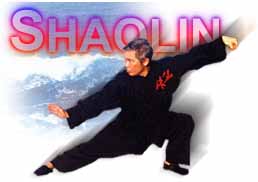COMBAT
APPLICATION OF SHAOLIN KUNG FU
Can
Kung Fu be Used for Fighting?
Due to
various reasons, many people only learn Kung Fu form, without progressing
to developing force and sparring, and without understanding Kung Fu
philosophy although they may have read its cliches.
Today
it has become a norm that a Kung Fu student does not know how to defend
himself even if he has learnt so-called Kung Fu for many years. Some
even wonder whether Kung Fu can be used for fighting.
Others
consider Kung Fu patterns too complicated, and advocate simplifying
Kung Fu movements to straight-forward punches and blocks.
Crystallization
of Effective Fighting
Actually
all the Kung Fu patterns we have today are the crystallization of
centuries of effective fighting. In other words, past masters have
evolved through the centuries the most effective ways to overcome
particular combat situations, and have stylized them into Kung Fu
patterns.
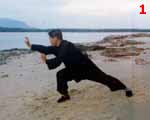 Let us take for an example the following Shaolin pattern called "Fierce
Tiger Descending from Mountain", Photo 1. Uninitiated students may
have performed this pattern many times in solo practice without knowing
what it is for; some may think it is too flowery to have any practical
uses.
Let us take for an example the following Shaolin pattern called "Fierce
Tiger Descending from Mountain", Photo 1. Uninitiated students may
have performed this pattern many times in solo practice without knowing
what it is for; some may think it is too flowery to have any practical
uses.
 A likely
evolution of this pattern is as follows. Past masters found that they
could effectively block a thrust punch using a particular movement
as in Photo 2, now stylized into a Shaolin pattern called "Immortal
Emerges from Cave".
A likely
evolution of this pattern is as follows. Past masters found that they
could effectively block a thrust punch using a particular movement
as in Photo 2, now stylized into a Shaolin pattern called "Immortal
Emerges from Cave".
A
Better Alternative
 Later other masters discovered
a better alternative as in Photo 3, a pattern called "Single Tiger
Emerges from Cave", because by withdrawing the front leg and "leaning"
his arm against the attack instead of blocking head-on, the exponent
used less energy and was more flexible.
Later other masters discovered
a better alternative as in Photo 3, a pattern called "Single Tiger
Emerges from Cave", because by withdrawing the front leg and "leaning"
his arm against the attack instead of blocking head-on, the exponent
used less energy and was more flexible.
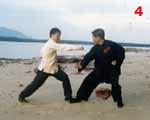
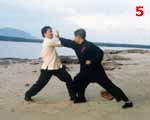 Subsequent
masters discovered that the exponent did not even have to withdraw
his leg or block the attack. By shifting his body backward, but without
moving his leg position, the exponent allowed the punch to pass, Photo
4. Shifting his body forward again he "leaned" his arm against the
opponent's attacking arm, with his tiger-claw against the opponent's
face, Photo 5. All these are performed in one smooth, continuous movement,
and is now stylized in a pattern called "Single Tiger Presents Claw".
Subsequent
masters discovered that the exponent did not even have to withdraw
his leg or block the attack. By shifting his body backward, but without
moving his leg position, the exponent allowed the punch to pass, Photo
4. Shifting his body forward again he "leaned" his arm against the
opponent's attacking arm, with his tiger-claw against the opponent's
face, Photo 5. All these are performed in one smooth, continuous movement,
and is now stylized in a pattern called "Single Tiger Presents Claw".
Avoiding
Weakness
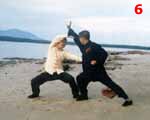 But the masters
realized that while this was an effective pattern, it had a weakness;
it left the side-ribs exposed. A competent opponent could easily "float"
the attacking tiger-claw, and simultaneously strike the side-ribs
with the other hand in a pattern called "White Horse Lifts Head",
Photo 6.
But the masters
realized that while this was an effective pattern, it had a weakness;
it left the side-ribs exposed. A competent opponent could easily "float"
the attacking tiger-claw, and simultaneously strike the side-ribs
with the other hand in a pattern called "White Horse Lifts Head",
Photo 6.
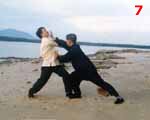 To avoid this possibility, past masters used two tiger-claws instead
of one. Pressing his right forearm against the opponent's upper arm
and feigning a tiger-claw attack to the face, the exponent strikes
the opponent below with another tiger-claw, Photo 7. This is now stylized
into a pattern called "Fierce Tiger Descends from Mountain".
To avoid this possibility, past masters used two tiger-claws instead
of one. Pressing his right forearm against the opponent's upper arm
and feigning a tiger-claw attack to the face, the exponent strikes
the opponent below with another tiger-claw, Photo 7. This is now stylized
into a pattern called "Fierce Tiger Descends from Mountain".
Importance
of Force and Skill
Using
effective techniques constitutes only one of numerous factors necessary
for victory in combat. Another important factor is what is known in
Kung Fu terminology as "kung", which is roughly translated as force
or skill.
You many
apply this Fierce Tiger technique correctly, but without "force" --
which in this case depends much on your stable Bow-Arrow stance --
you would not be able to "control" your opponent with your right forearm,
nor cause sufficient damage with one tiger-claw palm strike at close
quarters.
Without
skill -- which includes fluidity of movement, right timing and correct
spacing, you would not be able to implement the technique effectively.
In the
Shaolin tradition, such force and skill are not acquired haphazardly
in free sparring, but developed systematically using appropriate methods.
Thus, before a Shaolin student starts to practise sparring, he has
to spend some time on force training.
Flowery
Fists and Embroidery Kicks
If you
go straight to sparring without first learning and perfecting your
Kung Fu forms, you may improve your fighting ability through your
own experience, but you will missed the centuries of experiences of
past masters who have crystallized their collective fighting ability
for you.
On the
other hand, if you merely learn Kung Fu forms without developing "force"
and methodologically learning how to spar, you will help to perpetuate
what past Kung Fu masters referred to as "flowery fists and embroidery
kicks" -- pretty movements meant to please spectators but unfit for
combat.
Golden
Bridge
A fundamental
exercise in Southern Shaolin Kung Fu to develop both powerful arms
and solid stances is called the "Golden Bridge". It looks simple;
basically it consists of "sitting" on a Horse-Riding Stance and holding
both arms straight ahead with the hands in a "One-Finger Zen" formation.
Like
Shaolin Kung Fu patterns, this Golden Bridge exercise was not invented
out of the blue, but evolved over many centuries through many processes.
While it is very difficult for those who have not spent some time
in this exercise to believe how profoundly powerful it is, it is easy
for the uninitiated to think its training a waste of time.
They
reason, superficially, that in actual fighting one does not hold the
arms and stand motionlessly as in the Golden Bridge exercise. What
they fail to realize is that the exercise is not meant to be a fighting
technique, but meant to develop powerful arms and stable stances so
that the exponent can execute any fighting techniques more effectively.
Don't
Fight Like Children!
But even
if you can perform Kung Fu patterns in solo practice and know how
to use them to overcome combat situations, as well as have developed
sufficient force and skill to back your techniques, you still cannot
spar well until you have actually practised sparring methodically.
Merely
donning a pair of boxing gloves and starting to spar is one sure way
of making you appear like a clown or into a sitting duck for experienced
karate, taekwondo or kickboxing exponents. When they attack you, you
will be unable to defend yourself with the beautiful Kung Fu techniques
you have arduously learnt in solo practice.
The reason
is simply you have never learnt how to spar, no matter how many years
you may have spent in practising solo Kung Fu sets.
Unable
to Use Kung Fu Patterns
Set practice
is meant to familiarize you with effective Kung Fu patterns.. After
you can perform Kung Fu patterns flawlessly, you have to practise
applying them in combat situations, and this has to be carried out
methodically.
The usual
problem is that students do not know the methods and the procedure.
The result is pathetic: it is not uncommon to find Kung Fu exponents
with more than 10 years experience fight wildly like children.
The more
experienced fighters perform better, but what they use are usually
not the Kung Fu techniques that they have learnt, but techniques borrowed
from other martial art systems, especially karate, taekwondo and kickboxing.
Indeed,
if not for the Kung Fu costumes they wear and the few Kung Fu poses
they sometimes use before the actual combat, spectators in a sparring
competition would be unable to tell whether they are Kung Fu exponents.
In sparring competitions of any other system, irrespective of whether
it is judo, karate, aikido, taekwondo, wrestling or kickboxing, spectators
are easily tell what art is involved.
A
Poor Excuse
A common
excuse given by some Kung Fu instructors for the poor performance
of Kung Fu competitors is that the wearing of boxing gloves required
by many competitions restricted Kung Fu expression.
While
it is true that with the gloves on, many Kung Fu techniques like the
tiger-claw, the dragon-hand and the mantis-hook cannot be effectively
employed, it is also true that the remaining Kung Fu techniques that
can be effectively employed are overwhelmingly more than all the techniques
in all the remaining martial art systems put together!
Take
the clenched fist, for example. A Kung Fu exponent donning boxing
gloves can have a dozen ways of using the clenched fist, whereas an
exponent in most other martial arts has only three or four.
There
are more than 30 types of leg techniques in Kung Fu, whereas in most
other martial arts there are less than five.
Be
True to Yourself
Even
the basic Kung Fu stances -- which many Kung Fu instructors say, on
their lips at least, are important -- are discarded in a competition
ring for bouncing about as in western boxing.
If the
students and their instructors believe that these techniques from
other martial arts are more effective, they should be true to themselves
and leave Kung Fu for these other martial arts. It is time-costly
to spend five years learning Kung Fu patterns to be thrown away to
the winds in a competition ring, and settle for karate or taekwondo
techniques which they have hardly trained enough.
Personally
I believe Kung Fu techniques are more effective. If I am beaten by
an exponent of another martial art, it is not because Kung Fu is not
efficient, but because I have failed to use it well.
Because
the repertoire of Kung Fu is wider and deeper than that of other martial
arts, it takes more time to practise it. But that doesn't mean we
practise blindly. We should assess our results with reference to the
effects our art is purported to give.
If Kung
Fu is purported to be an effective fighting art, we should be able
to use Kung Fu movements to put up some decent defence even if we
lose the combat. If not, we have to review our training procedure,
or change to another martial art.
Kung
Fu is an Exceedingly Effective Fighting Art
In reality,
Kung Fu -- any style of Kung Fu, including taijiquan -- is an exceedingly
effective fighting art. There are various reasons why an overwhelming
majority of Kung Fu students cannot use their Kung Fu techniques to
fight.
Firstly,
most of them do not know, even theoretically, how the techniques are
applied for combat. Secondly, they do not have the necessary "kung",
such as power, speed and fluidity. Probably the most serious factor
is that they have had little or no methodical practice in sparring,
even among classmates. Most Kung Fu training, especially in its modern,
demonstrative form as "wushu", concentrates on solo performance.
Photos
8-11 illustrate some Shaolin Kung Fu techniques against the four main
types of kicking attacks. Defence against kicks is chosen because
many Kung Fu students do not know how to counter kicks, as well as
have a mis-conception that Kung Fu has few kicking techniques.
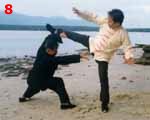 In
Photo 8, as the attacker executes a high kick, the Kung Fu exponent
moves in diagonally, "floats" the attacking leg, and simultaneously
strikes the attacker's vital organ, using a pattern called "Bailing
the Moon from the Sea". But Shaolin disciples normally stop short
just before the target to avoid hurting the opponent. High kicks such
as shown here by the attacker are strongly discouraged in Kung Fu.
In
Photo 8, as the attacker executes a high kick, the Kung Fu exponent
moves in diagonally, "floats" the attacking leg, and simultaneously
strikes the attacker's vital organ, using a pattern called "Bailing
the Moon from the Sea". But Shaolin disciples normally stop short
just before the target to avoid hurting the opponent. High kicks such
as shown here by the attacker are strongly discouraged in Kung Fu.
 The attacker
executes a middle side-kick in Photo 9. The Kung Fu exponent withdraws
his front leg diagonally backward, thus avoiding the kick, and simultaneously
strikes the attacking leg to fracture it, in a pattern known as "Lohan
Strikes a Drum".
The attacker
executes a middle side-kick in Photo 9. The Kung Fu exponent withdraws
his front leg diagonally backward, thus avoiding the kick, and simultaneously
strikes the attacking leg to fracture it, in a pattern known as "Lohan
Strikes a Drum".
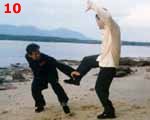 In Photo 10,
the attacker uses a low kick to strike the exponent's groin. The exponent
withdraws his front leg into a False-Leg stance to avoid the attack,
and simultaneously breaks the attacker's shin with a palm strike,
using a pattern known as "False-Leg Hand-Sweep".
In Photo 10,
the attacker uses a low kick to strike the exponent's groin. The exponent
withdraws his front leg into a False-Leg stance to avoid the attack,
and simultaneously breaks the attacker's shin with a palm strike,
using a pattern known as "False-Leg Hand-Sweep".
Simple, Direct and Effective
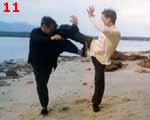 In Photo
11, the attacker uses a round-house kick. The Kung Fu exponent moves
slightly forward towards the other side, and simultaneously executes
a thrust kick at the attacker's groins with a pattern known as "White
Horse Presents Hoof". As usual, the Shaolin disciple stops short just
before hitting the target -- in this as well as the other examples.
In Photo
11, the attacker uses a round-house kick. The Kung Fu exponent moves
slightly forward towards the other side, and simultaneously executes
a thrust kick at the attacker's groins with a pattern known as "White
Horse Presents Hoof". As usual, the Shaolin disciple stops short just
before hitting the target -- in this as well as the other examples.
The Kung
Fu techniques shown above are simple, direct and effective. It is
a big mistake to think that Kung Fu is elaborated or flowery, full
of frills meant for demonstration but unnecessary for combat. If you
are well trained, as soon as your opponent attacks, you stop him with
just one stroke. The numerous exchanges of attack and defence, and
sometimes of kicks and blows, you see in Kung Fu movies are meant
to entertain movie viewers; they rarely happen in real fights.
Please
note that techniques are only one of numerous factors determining
victory in a combat. Other factors include force, speed, judgement
and temperament, which are "formless" and are often more significant
than techniques which has "form".
In other
words, a Kung Fu student may know the beautiful form of fighting techniques,
but if he has no striking power, is slow, confused and panicky, he
is likely to be beaten by an ordinary street-fighter who knows no
martial art. In fact the term "Kung Fu" refers to the training of
these factors collectively called "kung". Like the techniques, the
training of "kung" in Shaolin Kung Fu is also simple, direct and effective.
The secret
of developing "kung" is practice. In fact the word "Kung Fu" sometimes
refers to "time", i.e. the time required to master these formless
combative factors or "kung".
Procedure
to Train Sparring
While
you aim to stop your opponent with just one strike, if he is competent,
he will be able to counter your strike and so an exchange will occur
-- though in real life it is seldom like what you see in a Kung Fu
movie. Sparring practice is a good way to train for such combative
exchanges.
Different
masters have different ways of connecting the gap between set practice
and free sparring. One effective way used in Shaolin Wahnam Kung Fu
is as follows.
- Understand
and apply selected Kung Fu techniques to overcome specific combat
situations.
- Arrange
these specific techniques into short meaningful combat sequences.
- Gradually
release control over pre-arranged sequences.
- Introduce
variations at appropriate points of the combat sequences.
- Link
short sequences into longer encounters.
- Gradually
diminish control over long encounters.
- Introduce
variations or changes at any point at will.
Although
this section focuses on combat application, combat efficiency is only
one of the many benefits of Shaolin Kung Fu training. In today's law-abiding
society, this martial function is rarely used, yet the effects of
practising Shaolin Kung Fu as a martial art, and not as "flowery fist
and embroidery kicks", are readily and rewardingly transferable to
our daily living. If you are trained to have the stamina to last an
hour's sparring, the agility to executive fast, complex movements,
and the mental freshness to make-split second decisions, you will
have sufficient ingredients to meet life's mundane tasks.
It is
pertinent to remember that Shaolin teaching abhors brutality and aggression.
A Shaolin disciple will fight well if he has to, but he never glorifies
fighting. Becoming a fearless or fearsome warrior has never been a
Shaolin ideal; a Shaolin disciple rather chooses to lead a quiet but
meaningful life, one that is rewarding to others as well as to himself.
